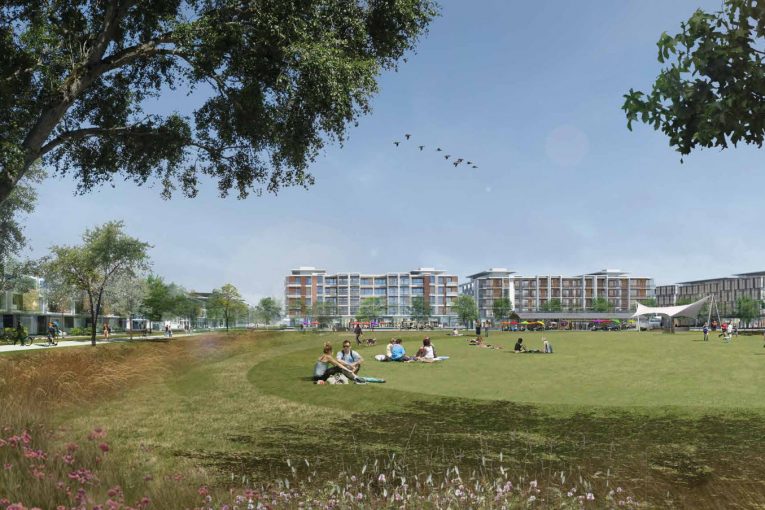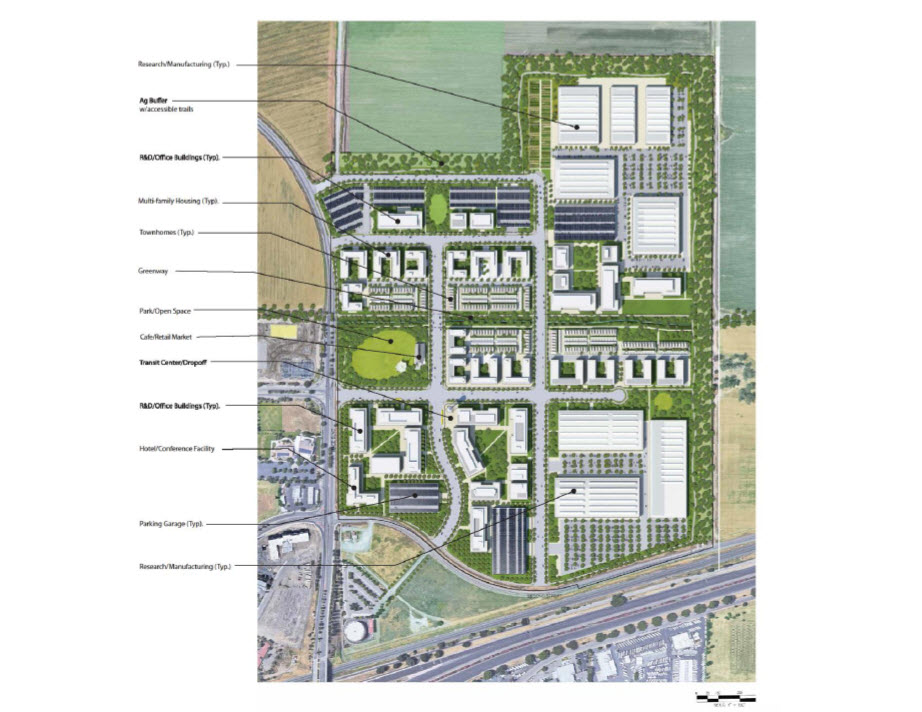

A number of opponents of the Aggie Research Campus project got up Tuesday night to complain about the lack of public meetings on the project. While I think a lot of that is an attempt to impose paralysis by analysis on the project, they also give the city and project applicants a chance to understand potential concerns and address them.
Moreover, there are some important points that were raised here by Assistant City Manager Ashley Feeney.
“Right now we’re talking about zoning of land, not necessarily specific designs where you would typically review those details,” he said.
He added, “Absolutely the project will be going to those commissions – it’s a matter of what time does it make the most sense.” He suggested that “it will be post this pre-zoning entitlements.”
This is hugely important for people to understand – we have created a Measure R process that may well work much better for housing which can be meticulously designed upfront and is built within a short period of time.
On the other hand, that is not how an Innovation Center is going to work. Instead, we are going to see an upper bound for development – 2.6 million square feet of R&D space, 850 residential units, and a certain amount of that must be affordable with other standards that will be put in place.
But the build out of the innovation center is not going to be over a five- or even ten-year period. Moreover, much of it will be internal project-dependent. The first stage will see basic  infrastructure laid. Perhaps there will be initial anchor companies.
infrastructure laid. Perhaps there will be initial anchor companies.
But over time projects will come in, be designed at that time, and then have to go through an additional planning process.
We started to see this with the affordable housing proposal in front of the Social Services Commission. As we saw with the comments by Ashley Feeney and some of the comments here on the Vanguard, that will probably represent a bit of a problem for voters wanting specificity and mistrusting city planning processes.
What we are used to with these projects is the Nishi/WDAAC model – the proposal is laid out, we have the exact details and layout of the project, the mitigations, the requirements and everything. The voters knew exactly what they were voting for.
That is not how ARC is going to work. In a way this is much closer to what I suggested several years ago. Basically, they are going to ask the voters to re-zone the land, and they are going to put parameters on that re-zoning but the specifics are going to depend on commercial entities that decide to move to the campus.
It behooves the city and applicants to make this part very clear upfront. Moreover, while many of the details of the project are not going to be known until much later, the city council needs to make sure that the project has as many protections, assurances, and guidelines as possible to allow the voters to be comfortable that making an affirmative vote does not allow for carte blanche authority for bait and switch later.
Along those lines, I have several thoughts.
First, while there is not going to be the specificity in design you would see with a housing project, the city can make certain requirements – things like phasing, size, density, FAR (floor area ratio), transportation, affordable housing, trees, parks, open space, etc. can be written into the project baseline features.
As readers will recall, according to the Measure R ordinance on the book, the voters are approving “changes to land use designations on the Land Use Map from agricultural or urban reserve to urban land use designations.” That is the core of Measure R.
Allowing for more flexibility in the project does not undermine Measure R at all. It simply allows the project that is quite different from a typical housing development to have be able to progress organically.
One of the biggest protections that voters have to guard against bait and switch is the establishment of baseline project features.
There are “requirements such as recreation facilities, public facilities, significant project design features, sequencing or phasing, or similar features and requirements as shown on project exhibits and plans submitted for voter approval, which cannot be eliminated, significantly modified or reduced without subsequent voter approval…”
This is the key. The Measure R process creates a degree of certainty that you do not get with non-Measure R projects.
So what can be locked into the project? Size – we can set a maximum size. The number of housing units. The number of affordable housing units. The location of those housing units. The phasing of the project. And much more.
What is being proposed here is not the circumvention of Measure R – it is an understanding that the way we have passed projects previously is going to be different from the way a project like ARC has to proceed.
With that said, there are several other things I would like to suggest.
First, while the people who came forward on Tuesday are undoubtedly opponents of the project and will attempt to undermine it and oppose it regardless, send the project to every commission that people believe will be helpful. There really is no harm or downside to doing it and it takes an issue away from the opposition.
The Tree Commission will have some ideas about the number and placement of trees – none of that is going to be binding anyway, but you might as well have those recommendations up front.
Second, affordable housing is crucial. What the Social Services Commission put forward as a recommendation seemed too loose for most voters. My suggestion is to lock in some of that stuff upfront – make it on-site, and my suggestion would be to set aside five to ten acres and turn it over to an affordable housing developer to raise the funding and build the housing. That is all stuff that can be put in the baseline features and be locked into place.
Finally, note that the applicants cannot simply develop housing first or as quickly as possible. As we previously reported: “Future residential project proposals at ARC will be required to apply to the City for entitlements. Housing will be constructed in phases over the course of several years concurrent with the development of commercial.”
Remember, you can lock the phasing into the project baseline features and it become immutable without another vote of the people. Those are the kinds of safeguards that can and should be locked into place.
Finally, once again, we may not have the specific designs of this project up front, but we should be able to lock enough into place to assure the reasonable voter that what they are voting for is not simply a blank check. That what will be built will resemble what they have been told will be built.
—David M. Greenwald reporting







As noted yesterday, the proposal apparently may exceed 850 units – when including the Affordable housing (which may be located off-site).
If they try to pull that kind of stuff, they’ll lose.
I’m not sure that the proposal is financially viable, if they have to reduce the number of market-rate units to account for the Affordable units.
Seems to me that they’re probably counting on the (full allotment) of market-rate residential units to make the entire development “pencil out”, as they say.
I recall that you (and others) mentioned the 25-acre city-owned site, as something that the developers might consider to accommodate the Affordable housing. Which would apparently allow the proposal to exceed 850 total units, and would result in the elimination of 25 acres of city-owned open space.
I’m not completely familiar with the history of the 25-acre city-owned, open space site. Perhaps this is something that could be the focus of an article.
I don’t that think you have a basis for the first comment on fiscal viability.
Second, the council and social services commission have been pretty clear that they want affordable housing on-site. There is no reason on a 200 acre project that you can’t designate 5 to 10 acres for a land dedication.
Third, trying to use off-site to go higher than 850 would be a losing proposition. If they really needed more market rate they should have gone with a higher number to begin with.
I’ve never suggested using the 25 acre site for anything other than open space or an urban farm. I did at one point tell you that they could put affordable on that site as a standalone project without a measure r vote, but that was not a suggestion that they would or should do that.
Aren’t Affordable housing requirements for “mixed-use” not firmly established? Isn’t that the reason that Nishi 1.0 didn’t have any, and the reason that the University Mall proposal isn’t including any Affordable housing?
Regarding the council, I’m not sure that they’ve been “clear” regarding anything related to this proposal. Of course, the proposal itself isn’t “clear”, either.
Regarding a 5-10 acre site within the development, maybe so. Of course, there’s yet another chunk of land for housing, instead of commercial development (which is supposedly the purpose of the proposal).
The affordable requirements for mixed-use are fairly set, but the council will put those allocations into the baseline features regardless. The vertical mixed use is a bit different than just mixed use.
“Regarding the council, I’m not sure that they’ve been “clear” regarding anything related to this proposal. Of course, the proposal itself isn’t “clear”, either.”
It hasn’t come to the council for approval yet and the baseline features have not been created.
“Regarding a 5-10 acre site within the development, maybe so. Of course, there’s yet another chunk of land for housing, instead of commercial development (which is supposedly the purpose of the proposal).”
No, you set the amount of R&D and retail. And you can adjust the density to fit other things as needed.
Then, you were not paying attention… well documented in the media, in real time.
Well, rental housing is clearly/inherently “commercial” development… but, housing… just saying… words are important… rental housing IS “commercial”…
Maybe so, as it apparently occurred years ago. Perhaps others aren’t intimately familiar with it, as well.
I suspect that it’s a topic of interest, for some.
f you’re going to categorize rental housing as “commercial development”, then the city (clearly) has an abundant supply of commercial development, compared to residential development.
Where were you when David repeatedly claimed a lack of “commercial space” within the city?
Below is a link to an article regarding the history of the 25-acre, city-owned open space site, and how it got into the MRIC proposal:
https://www.davisenterprise.com/forum/opinion-columns/how-25-acres-of-open-space-got-into-the-mric-proposal/
Ron, you will get a wealth of information on the 25 acres if you enter the expression “Mace 391” into Google. No need for a redundant article when it is so easy to let your fingers do the walking.
Matt: I’m consistently amazed by suggestions that topics which are directly related to the issue at hand have “no place” on this blog. (You’re not the only one who has done so.)
Just because you’re not interested (or might already be intimately familiar with the topic) doesn’t mean that others share your lack of interest. And again, others have suggested that this 25-acre site might still be “in play”, regarding the Affordable housing component for ARC.
Again, here’s a link to the history (and how it was included in the MRIC proposal). However, I’m sure that more information can be gleaned by your (additional) suggestion, as well.
Of course, readers can choose for themselves, if they’re interested in reading any of the comments on this blog. But, they’re also (because of “extraneous” suggestions, such as yours, and my response to it) forced to “sift through” those, as well.
https://www.davisenterprise.com/forum/opinion-columns/how-25-acres-of-open-space-got-into-the-mric-proposal/
Ron, I personally find “sifting” through historical Vanguard articles and their comments threads much, much, much more cumbersome than using Google to sift through historical articles. In addition to Vanguard references to the key words/expressions one uses in the queries, one also gets materials from other sources, which produces a more balanced perspective when the results of the “hits” are aggregated together. I have always found multiple sourtces to be preferable to single sources when researching an issue.
I don’t disagree with that, Matt. In fact, one could probably find a link to the article I posted pretty quickly, that way.
I just provided the link in case anyone was interested.
Truth be told, a large number of the Vanguard articles themselves are “built” around a single source. I believe it’s sometimes useful to include links to other sources, for balance.
And in this case, I’m not sure that the Vanguard explored the topic I referred to, at all. I certainly don’t remember a link to the Enterprise article which you described as “redundant”.
Ron, I didn’t describe the Enterprise article as redundant. I described the future, un-written Vanguard article you were calling for as redundant.
If you look in the Vanguard archive in February 28, 2015 you will find the following article “What Should the City Do With Mace-25?”
[edited]
Typo, or intentional?
Sure… submit one at your convenience… pretty sure David will post it for you.
In reference to a comment without response (from yesterday), does the 15-acre privately-owned parksite proposal (within the site) address city requirements for this type of development (regarding size, ownership, maintenance, etc.)?
Which commissions will (supposedly) weigh in on that?
And come to think of it, would a park site be required at all, if the development was entirely commercial – as originally planned and specifically sought-out, by the city?
How much of the site is actually proposed to be used for commercial activities?
The commercial part of the site is 2.6 million square feet of R&D and there’s some retail and other space as well. The thing about other uses is that you can have those other uses because of density and FAR that you have the ability to tweak.
I was asking about the number of acres for commercial activities.
The same measurement that you refer to regarding a “shortage” of acres within the city, for commercial activities.
The acres are not the key variable, density and square footage are.
Perhaps that’s what you should focus on, when discussing existing sites within the city. Instead, you focus on “acres” within the city, and “square footage” at ARC.
In any case, it would be interesting to compare the number of acres at ARC that will be used for commercial activities, vs. the number of acres that will be used for other purposes (as a result of the inclusion of housing).
That’s why I asked if a park site would be “required”, if the entire site was proposed for commercial activities (as originally planned).
This is a 200 acre site that has plenty of room for all proposed uses. The sites in town are for the most part very small and isolated from each other. It’s not an apples to apples comparison.
I recall that another commenter presented a thorough analysis regarding the (existing) potential commercial space within the city.
Again, if you’re going to talk about a lack of acres in the city, it would make logical sense to discuss how many acres of the ARC site would be dedicated for commercial activities.
And, how that compares with the original MRIC commercial proposal.
That would provide the “apples-to-apples” comparison regarding your claims of lack of acres within the city.
Either that, or compare the square footage at ARC, with the potential square footage within the city for commercial activities.
Again, and “apples-to-apples” comparison.
Of course, the city has been busy encouraging and approving conversions of existing commercial space (and/or potential space) for residential usage, instead.
Another interesting metric might be to compare the ratio of space proposed for housing (and related uses), vs. commercial space at ARC.
And, how that compares to the ratio of residential vs. commercial space within the city.
Recall that the original purpose of MRIC was to provide a “better-balance” of commercial space vs. existing residential space within the city. Since ARC includes housing itself, it does not address this supposed “need” as well as the original MRIC proposal.
I suspect that the ratio of commercial vs. residential usage within the city as a whole would barely budge, as a result of ARC.
Instead, ARC would (for the most part) simply make the city “larger”.
That’s a good question. I suggest sending an email to the Planning, Parks, and Natural Resources Commissions about that issue. It will get an examination by the NRC.
Ron… see government code section cited in most recent legislation, https://leginfo.legislature.ca.gov/faces/billTextClient.xhtml?bill_id=201520160AB1191
There is no Quimby Act, nor City ordinance (which incorporates State law, by reference) requirement for non-res development… it provides for either land dedication or fees (or combo)…
The facts will set you free (to say whatever you wish)…
Thanks – that’s what I suspected.
So, the inclusion of housing at ARC (which results in a need to include space for a park) results in an additional 15-acre reduction (the size of the proposed privately-owned park) regarding the amount of space available for commercial use.
In addition to the other acreage dedicated or needed to support residential usage.
It would be interesting to see some kind of metric which shows the acreage that will be needed to support housing, vs. the acreage for commercial at ARC. Perhaps it’s not a clear delineation.
But the size of the innovation space is the same – 2.6 million square feet. This is the point I keep making.
The “same” as what?
Since residential development (and related uses) would occupy a significant portion of the site, are you suggesting that 200 acres is far more than what was needed to house 2.6 million square feet for commercial activities?
The same as the previous proposal
Seems to me that there are/were several proposals. some (or at least one?) of which also included the 25-acre city owned site:
1) A commercial development occupying the entire site.
2) A commercial development occupying a portion of the site.
3) One of the alternatives in the EIR, which includes housing.
4) Whatever is (or might be) proposed, now.
But again, my question to you is as follows:
Which is a point I made way back in 2014: density is not high enough
https://www.davisvanguard.org/2014/10/analysis-should-davis-push-for-more-density-at-mace-ranch-innovation-center/
If you believe that then I have got a great deal on a bridge for you!
Isn’t that what project baseline features are for?
If housing is going to be concurrent with commercial development and the commercial project buildout is 20 years, then the housing buildout will presumably also be 20 years and not “several years” as you suggest. But I doubt that is what the developer has in mind, eh?
Fol should understand the history of University Research Park… the CC pressured the developer to add housing (Tanglewood Apartments)… Kaiser bought 4 lots, and is using ~ 2/3 rds of that… there is a hotel/motel… Families First had a site… now a home for YSAQD… IHOP is there…
That R/D park morphed, with many subsequent approvals needed… it was approved ~ 1985, and is still not ‘fully built out’… will likely have some sites ‘re-developed’… and will require additional applications, review (including public), approvals to do so.
Any one who wants absolute assurance of an outcome… I offer this… birth has many changes/challenges in the course of life. And is guaranteed to end in death, at some point. I assure you, absolutely, we shall all die. Reality.
In the meantime we need to evaluate “change”, and accept, within some transitory rules, that things change… it’s called life.
OK… will accept the “broken record” charge…
Measure R should lapse… the thought of just extending it, with all its flaws… well, I’ll not vote to do so. If it tries to be MORE stringent, will actively campaign against. If it is amended to be reasonable, am willing to discuss.
There are other remedies besides Measure J/R. Always have been.